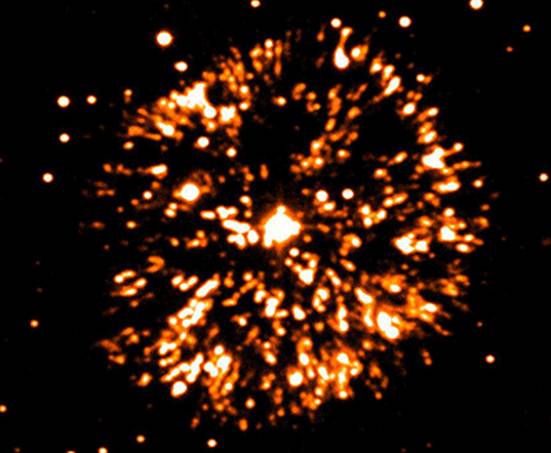Create a free profile to get unlimited access to exclusive videos, sweepstakes, and more!
Expanding Fireworks from a Century-Old Stellar Explosion

GK Persei was, after all, a ticking time bomb. A star that was once like the Sun, it died a hundred thousand years ago, shedding its outer layers and becoming a white dwarf, the compressed core of the dead star. It has a companion, a star that is still âaliveâ, in the sense that it is fusing hydrogen into helium in its core like our own star does. The white dwarf, though, is a vampire: It feeds off its companion, drawing material off its companion, a stream of hydrogen that piles up on the surface of the tiny dead star.
But while the white dwarf is small, it is powerful: Its surface gravity can be hundreds of thousands of times the Earthâs. The matter from the other star piles up, but the immense and increasing pressure it feels cannot be mitigated. Eventually, when the squeezing gets high enough, the material undergoes thermonuclear fusion and explodes like a nuclear bomb. Or, more accurately, like a million trillion nuclear bombs.
The explosion blasts the material off the surface and away, into space. It took 1300 years for the light from the dwarf nova, as itâs called, to reach the Earth, arriving in 1901. For a brief time, Nova GK Persei was among the brightest objects in the sky. It has faded in the subsequent decades, but the material from the blast still rushes away from the star. Observations of this object have been made for a long time, and now astronomers have made an incredible animation of it using actual data:
Amazing. The early observations were lower resolution, but better telescopes and detectors have cleared things up considerably in recent times. The later observations were made using the Isaac Newton Telescope, a 2.5 meter telescope in the Canary Islands.
The astronomers who took this data also took very accurate spectra of the nova, breaking the light up into thousands of individual colors. That allowed them to measure the speed and direction of the expanding debris, and they found something rather astonishing: Over the past century, the expansion has hardly slowed at all. Weâd expect the material to slow as it slams into the thin material between the stars, but instead the debris is still rushing outward at speeds of 600 â 1000 kilometers per second (360 â 600 miles/second). Thatâs up to a thousand times faster than a rifle bullet!
Interestingly, the overall structure appears to be very spherical. That too is surprising, as previous observations using radio and X-ray telescopes indicated it should be more elliptical, flattened. Itâs unclear why this might be, but it must have to do with the way the two stars interacted at the time the material erupted off the dwarf, as well as the way the expanding debris is interacting with the interstellar material around it.
Dwarf novae like GK Persei are more than just cosmic curiosities. Under different circumstances, the matter from the companion star can pile up so much that the ensuing explosion does more than just blast matter away; it can disrupt the entire white dwarf star, shredding it completely. When that happens the entire star explodes, releasing as much energy in a short time as the Sun does in its entire lifetime.
This is a supernova, and it creates heavy elements like calcium and iron. Those materials can find their way into newly-forming stars, into newly-forming planets. In fact, some did so billions of years ago, helping to create the Earth. Eons later, your body uses those elements to make bones, blood, and even DNA. You literally owe who you are to some long-dead white dwarf, and GK Persei is one step in our understanding of just how all this fits together.
Video credit: Tiina Liimets, et al. Audio: Kevin MacLeod, "Mechanolith', incompetech.com


























